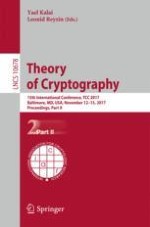2017 | Buch
Theory of Cryptography
15th International Conference, TCC 2017, Baltimore, MD, USA, November 12-15, 2017, Proceedings, Part II
herausgegeben von: Yael Kalai, Leonid Reyzin
Verlag: Springer International Publishing
Buchreihe : Lecture Notes in Computer Science
